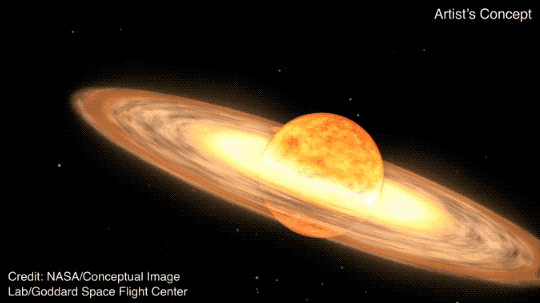Astrophysics
Voyager 2 Measured a Rare Anomaly When It Flew Past Uranus, Skewing Our Knowledge of the Planet for 40 Years, Study Suggests
The roughly six-hour flyby in 1986 revealed Uranus' protective magnetic field was strangely empty. Now, researchers say that the data could have been affected by a solar wind event
After Decades of Searching, Are Physicists Closing In on Dark Matter?
With no conclusive laboratory results, researchers are turning to other methods to find the elusive substance
Astronomers Are Watching for a Once-in-a-Lifetime Nova Explosion. When Will We See It?
A recurrent nova, known as the Blaze Star or T Coronae Borealis, is predicted to soon appear in the night sky. But the exact timing of the rare eruption remains unknown
Scientists Use Cold War-Era Spy Plane to Find Unexpected Gamma Rays in Thunderstorms
The new findings bring storm researchers one step closer to solving the mystery of how lightning forms
World's First Ultra-Precise Nuclear Clock Is Within Reach After Major Breakthrough, Researchers Say
The technology, enabled by thorium atoms, could keep time more accurately than atomic clocks and enable new discoveries about gravity, gravitational waves and dark matter
Astronomers Discover Record-Breaking Jets Escaping a Black Hole, the Longest Ever Seen
The energetic streams are together 23 million light-years in length—roughly as long as 140 Milky Way galaxies lined end to end
Mysterious 'Wow!' Radio Signal Might Finally Have an Explanation—and No, It's Not Aliens
The infamous signal recorded in 1977 might have been a laser-like beam of radiation from a hydrogen cloud energized by a powerful, magnetic star, preliminary research suggests
James Webb's Newest Image Shows a Giant Penguin and an Egg
NASA released the dazzling portrait to help celebrate the two-year anniversary of the release of Webb's first images
A 'Major Lunar Standstill' Is Happening This Year—and Friday's Full Moon Offers 'Dramatic' View
From now through much of next year, the moon will periodically rise and set at its most extreme points, thanks to a rare celestial phenomenon that only occurs every 18.6 years
This Giant Cosmic 'Butterfly' Is a Planet-Forming Disk
New research has confirmed that the celestial object may be the biggest of its kind ever found
See Five Dazzling New Images of the Cosmos, Captured by Europe's Space Telescope
With its visible and infrared photography, Euclid—known as the "dark universe detective"—is helping astronomers better understand dark matter and dark energy
James Webb Telescope Detects Earliest Known Black Hole Merger, Just 740 Million Years After the Big Bang
The new observations could help explain how black holes became so massive in the early universe
Where Do We Get Seeds for Seedless Fruit? And More Questions From Our Readers
You’ve got questions. We’ve got experts
Astronomers Discover an Atmosphere on a Hot, Rocky Exoplanet With an Ocean of Magma
It's the best evidence yet of an atmosphere on a rocky planet outside our solar system, researchers say, and studying the distant world could provide insight into Earth’s early days
A Rare Nova Explosion Will Soon Bring a 'New Star' to the Night Sky—How to Catch a Glimpse
In an event that occurs only once every 80 years, a distant remnant of a star will grow much brighter, briefly becoming visible to Earth
Dark Energy Could Be Evolving Over Time, Raising Questions About the Nature of the Cosmos
The largest 3D map of the universe ever made hints that dark energy might not be a constant, though the findings must be backed up with more data
This Is the Gear You Need to View the 2024 Total Solar Eclipse
Protect your eyesight with eclipse glasses, binoculars, telescopes or lens filters
Astronomers Capture Dazzling New Image of the Black Hole at the Milky Way's Center
The first image of the black hole taken in polarized light, the new view shows the supermassive structure's magnetic fields and hints that it could be hiding an enormous jet
How Ancient Texts Can Shed Light on Auroras
Documenting episodes of the phenomenon thousands of years ago may help us predict damaging solar storms in the future
Astronomers Discover the Brightest Known Object in the Universe, Shining 500 Trillion Times as Bright as the Sun
The quasar—a glowing, active core of a galaxy—has a black hole at its center that consumes more than a sun’s-worth of mass each day
Page 1 of 14
:focal(860x860:861x861)/https://tf-cmsv2-smithsonianmag-media.s3.amazonaws.com/filer_public/fc/b1/fcb131a6-5b51-4f73-a7f0-ee465ab796bd/uranus.jpg)
:focal(800x602:801x603)/https://tf-cmsv2-smithsonianmag-media.s3.amazonaws.com/filer_public/0e/28/0e28f9dd-3e1e-49ef-b8ca-312becf2c959/1e0657_web.jpg)
:focal(512x288:513x289)/https://tf-cmsv2-smithsonianmag-media.s3.amazonaws.com/filer_public/e2/8c/e28ce239-68d6-493b-9150-a2b36b7b7779/nova.webp)
:focal(1270x955:1271x956)/https://tf-cmsv2-smithsonianmag-media.s3.amazonaws.com/filer_public/7c/50/7c5081b9-0803-4ab1-8d29-30c210c19e65/gamma-ray-glows-visualizationpng_copy.png)
:focal(2184x1456:2185x1457)/https://tf-cmsv2-smithsonianmag-media.s3.amazonaws.com/filer_public/f8/94/f894d4fa-30e4-4ffd-b000-3e574196921c/gettyimages-94916159.jpg)
:focal(777x1013:778x1014)/https://tf-cmsv2-smithsonianmag-media.s3.amazonaws.com/filer_public/a5/6c/a56ce970-b506-470f-9a26-34c47ec1f69e/oei_martijn-giant_jet_system_porphyrion-weboriginal.jpg)
:focal(307x258:308x259)/https://tf-cmsv2-smithsonianmag-media.s3.amazonaws.com/filer_public/48/6e/486ede95-127a-4131-ac00-feacc81cff2b/wowcl.jpg)
:focal(2139x1354:2140x1355)/https://tf-cmsv2-smithsonianmag-media.s3.amazonaws.com/filer_public/94/63/9463bb82-fefa-4419-ab97-22b5c6033587/interacting_galaxies_arp_142_nircam_and_miri_image.jpg)
:focal(1920x1280:1921x1281)/https://tf-cmsv2-smithsonianmag-media.s3.amazonaws.com/filer_public/05/91/059191fc-b3c1-406b-89c0-27f492723ceb/pexels-peter-de-vink-288978-975012.jpg)
:focal(1800x1029:1801x1030)/https://tf-cmsv2-smithsonianmag-media.s3.amazonaws.com/filer_public/ac/67/ac6788b0-1d73-44f2-b968-a319ff7679e3/bigger_main_image_large.jpg)
:focal(4100x4100:4101x4101)/https://tf-cmsv2-smithsonianmag-media.s3.amazonaws.com/filer_public/41/9c/419c9894-6994-4251-83d5-8b16b640ac3b/euclid_s_new_image_of_star-forming_region_messier_78.jpg)
:focal(2000x2000:2001x2001)/https://tf-cmsv2-smithsonianmag-media.s3.amazonaws.com/filer_public/bb/6b/bb6bbcb6-6fa9-4c05-bca7-0c89fd918087/weic2413a.jpg)
:focal(760x572:761x573)/https://tf-cmsv2-smithsonianmag-media.s3.amazonaws.com/filer_public/87/3e/873eb70d-b8b7-4124-b9b2-67618bf74381/ask.jpg)
:focal(1000x571:1001x572)/https://tf-cmsv2-smithsonianmag-media.s3.amazonaws.com/filer_public/fc/90/fc9022fc-7d85-4a46-9b9c-826922f39b14/stsci-01hwqz4bjsgtdzc7fpdtvtnztc.jpg)

:focal(2000x1200:2001x1201)/https://tf-cmsv2-smithsonianmag-media.s3.amazonaws.com/filer_public/ea/d8/ead81125-df3b-468c-9cb9-804b41f8e3ab/noirlab2408b.jpg)
:focal(2377x1607:2378x1608)/https://tf-cmsv2-smithsonianmag-media.s3.amazonaws.com/filer_public/6c/55/6c556cbf-d7c6-43ac-bd2f-b3f9d47605f6/gettyimages-836328338.jpg)
:focal(1000x1000:1001x1001)/https://tf-cmsv2-smithsonianmag-media.s3.amazonaws.com/filer_public/05/fd/05fd3550-7ef1-46e3-9229-188eb270a02b/sgra_polarimetric_press_image-032724-lores.jpg)
:focal(800x602:801x603)/https://tf-cmsv2-smithsonianmag-media.s3.amazonaws.com/filer_public/72/ba/72ba90f4-730a-47b5-acd1-80a445b88a52/aurora_nagoya_1770_web.jpg)
:focal(2093x1316:2094x1317)/https://tf-cmsv2-smithsonianmag-media.s3.amazonaws.com/filer_public/01/22/0122eed6-f4f1-41e4-bca4-5e359ed38826/eso2402a.jpg)